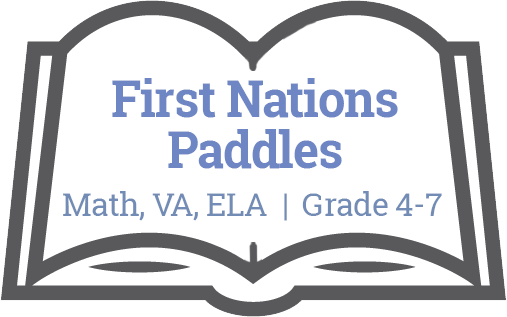
Unit Plan: First Nations Paddles
Math, Visual Arts, Language Arts / Grade 4-7

Big Ideas
Art, mathematics, and story-telling are vehicles to explore cultures and deepen our understanding of the world, bringing us closer together.
Concepts:
- Geometry
- Elements and principles of design
- Form
- The Writing Process
- Oral Storytelling
Essential Questions
Students will keep considering…
VISUAL ARTS
- How does art connect us, our communities, and our cultures?
MATH
- How does geometry help us make sense of the world?
LANGUAGE ARTS
- How does oral storytelling connect us to places and people?
- How can an open mind lead us to deeper understandings about ourselves and other cultures?
- Why does writing have a purpose?
Evaluative Criteria
Teacher Evaluative Criteria:
Teachers will be assessing students’ ability to:
- Create design that incorporates traditional Aboriginal design elements
- Make connections between the Aboriginal shapes and 2D shapes and 3D solids
- Work through the writing process
- Share their story orally
Monitoring Progress
Teacher will monitor progress:
Formative Assessment throughout: During class discussions, small group discussions and one on one conversations
Potential Student Misunderstandings:
N/A
Resources
- Examples of Coast Salish shapes and art
- Colouring Sheets that show a variety of First Nations shapes
- First Nations Support Workers/Aboriginal Success Teacher
- BLM of paddle shape
- Literacy 44 Graphic Organizers for How To Writing, Pourquoi Tales, and Story Writing Frames
Reflection
How will teachers and their students reflect on and evaluate the completed project?
Teacher:
Next time I teach this unit I would…
Student:
My students needed:
Process:
Product:
Content:
Potential Student Misunderstanding:
Downloads
Stage 2 – Evidence
Authentic Performance Tasks
AUTHENTIC PERFORMANCE TASK: Assessing for Understanding
Students will be able to demonstrate their understanding by:
- Listening to various Aboriginal oral stories in order to build their understanding of the importance of the oral tradition, place, and culture.
- Creating a 2D or 3D paddle, using knowledge of Coast Salish shapes in their design.
- Telling the story of their paddle (either how the paddle was made, or a fictional story it represents) in written format, making connections to their knowledge regarding Aboriginal place and culture.
- Orally sharing the story of their paddle with peers and younger students. They may do so in various ways (small groups, large groups, recorded).
GRASPS
What is a GRASPS task?
Other Evidence
OTHER EVIDENCE: Assessing for Knowledge and Skills
Students will show they have acquired Stage 1 knowledge and skills by:
- Demonstrating active listening skills when stories are told.
- Practicing Coast Salish shapes, reflected in nature, on paper.
- Explicitly expressing connections (style, structure, content), through Aboriginal storytelling.
- Completing graphic organizers (from Literacy 44), to help guide the writing process.
- Comparing and contrasting two dimensional polygons and three dimensional solids with traditional Aboriginal shapes (ovoids, split u, etc).

The following resources are made available through the British Columbia Ministry of Education. For more information, please visit BC’s New Curriculum.
Big Ideas
The Big Ideas consist of generalizations and principles and the key concepts important in an area of learning. The Big Ideas represent what students will understand at the completion of the curriculum for their grade. They are intended to endure beyond a single grade and contribute to future understanding.
Core Competencies
 Communications Competency
Communications Competency
The set of abilities that students use to impart and exchange information, experiences and ideas, to explore the world around them, and to understand and effectively engage in the use of digital media
 Thinking Competency
Thinking Competency
The knowledge, skills and processes we associate with intellectual development
 Social Competency
Social Competency
The set of abilities that relate to students’ identity in the world, both as individuals and as members of their community and society
Curricular Competencies & Content
Curricular Competencies are the skills, strategies, and processes that students develop over time. They reflect the “Do” in the Know-Do-Understand model of curriculum. The Curricular Competencies are built on the thinking, communicating, and personal and social competencies relevant to disciplines that make up an area of learning.
Additional Resources
First People's Principles of Learning
To read more about First People’s Principles of Learning, please click here.
For classroom resources, please visit the First Nations Education Steering Committee.
